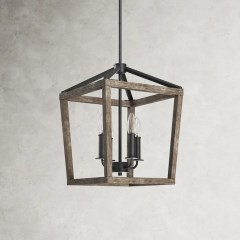
Fit with atmospheric lines and wide-scale lighting, this chandelier offers the best of fashion and functionality.
Fit with atmospheric lines and wide-scale lighting, this chandelier offers the best of fashion and functionality.
Cast in an oak wood that stands in a classical lantern-like frame. Features a built-in canopy to block excess light. Suitable for flat, vaulted, or domed ceilings. Works well for both indoor and outdoor environments.
Open design can create an overwhelming bright light.
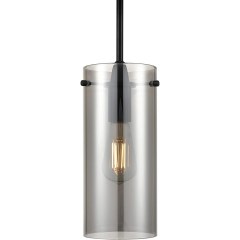
Crafted with beautiful smoked glass, this pendant light suits a variety of modern kitchens and living spaces.
Crafted with beautiful smoked glass, this pendant light suits a variety of modern kitchens and living spaces.
Offers more dim and subtle lighting compared to typical pendant lights. Simple to install in a variety of environments. Compatible with most major bulbs, including dimmable ones. Use as a centerpiece or with other lights.
Not a lot of sizes or options available.
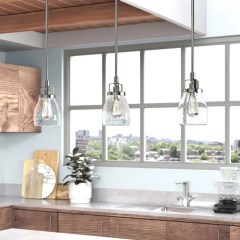
Users can adjust the height and direction of this pendant light to fit their own preferences.
Users can adjust the height and direction of this pendant light to fit their own preferences.
Surrounded by a brushed nickel finish that filters light for a warm glow. Users can adjust the height and location to suit their personal requirements. Available in bronze, black, and other colors.
Some users report that not all of the pendant lights look alike.
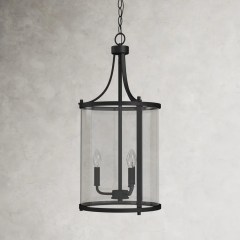
If you're searching for a more antique look, this traditional pendant light may be the pick for you.
If you're searching for a more antique look, this traditional pendant light may be the pick for you.
A cylindrical lantern shines light in all areas of the room. Mimics a traditional pendant lantern and works well with more classical styles. Offered in multiple styles, including black, English bronze, polished nickel, and satin nickel.
More delicate than it first appears.
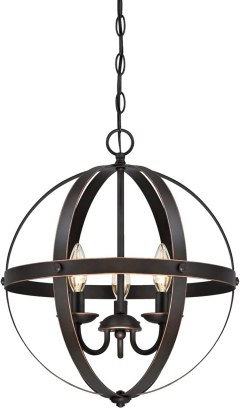
The best choice available if you want a sturdy light that complements most any room and offers versatile style with rugged, yet refined, construction.
The best choice available if you want a sturdy light that complements most any room and offers versatile style with rugged, yet refined, construction.
Combines contemporary design and distinctive craftsmanship in a 3-bulb model. Casts light with attractive shadows from the hardware and features an oil-rubbed bronze finish. Has an impressive 5-year limited warrant.
If you plan to install it yourself, you may find that the instructions are difficult to understand.

We recommend these products based on an intensive research process that's designed to cut through the noise and find the top products in this space. Guided by experts, we spend hours looking into the factors that matter, to bring you these selections.

Pendant lighting really is one of the most versatile, creative ways to light a home, and thanks to the many designs available, pendant lights are hardly boring. You’ll never need to raise a modern pendant light out of sight; they’re visually attractive, and if installed correctly, unobtrusive as well.
Home design is more complete and wholesome thanks to the existence of pendant lighting. But what’s the best way to utilize pendant lighting in your home? This buying guide goes through some popular design suggestions, along with plenty of tips and suggestions for using pendant lighting.

A pendant light is not a chandelier. A pendant light is suspended from the ceiling and has just one light bulb rather than several, and its light is usually aimed downward, providing direct illumination. Like a chandelier, pendant lighting makes a statement in the room.
Versions of pendant lighting have existed since ancient times. Thousands of years ago, oil lamps were suspended from the ceiling by woven cords, maximizing the area that could be illuminated by those tiny flames. Modern pendant lighting dates from the mid-1800s and really took off with the growth of electric lighting from the 1920s through today. While the art deco styles of the 1930s set the stage for pendant lighting design, mid-century modern designs took pendant lighting to a whole new level. It’s still informing the pendant lighting designs of today.
Pendant light fixtures are lighter than chandeliers in most cases, using only a single support chain or cord. They’re also far slimmer. This means they can be installed in places within the home where a chandelier just can’t go.
Pendant lighting usually provides direct light, unlike the ambient light that chandeliers provide. This makes it great for task lighting, illuminating spaces where visibility and a bright, open feeling are wanted, like narrow hallways.
Other good places for pendant lighting include:
Whimsical pendant shades fit best in relaxed design settings like playrooms or sun rooms.
An Underwriters Laboratories (UL) listing is essential to make sure the lighting product you’re buying is safe to use in the home.
Non-hardwired lights are a great option for renters and those who aren’t ready to commit to a hardwired fixture. Pendant lights wired with wall plugs or powered by replaceable or rechargeable batteries are widely available.
Shade: Pendant lighting shades cover the light bulb and help direct light downward. There are hundreds of varieties of light shades in different shapes, materials, and colors. Many times, pendant light shades can be swapped with another style as long as the new shade fits.
Socket: Attached directly to the electrical wires, the socket holds the pendant’s light bulb.
Dimmer: A pendant light may include a dimmer on its cord or via an infrared remote control. Look for this feature on the packaging or product description.
Canopy: This decorative cover attaches to the ceiling to hide the mounting strap and electrical wiring that power the pendant light.
Cord: A pendant light has a single cord that insulates its wires.
Cord cover/chain: A pendant light is supported safely by a single chain or a rod through which the wiring cord is threaded.
Light bulb: A light bulb may be included with a pendant light kit, especially if the bulb is integral to the style or the function of the light. More often, however, bulbs are sold separately. Check the recommended bulb type before installing the light fixture.

Some pendant lighting, like farmhouse-style fixtures, looks fantastic with retro-styled Edison bulbs. You can also opt for color-changing features or any bulb style that works for your light and your lifestyle.
If you’ve got a virtual assistant like Alexa or Echo, smart lighting is the way to go. You can easily set a timer for each smart bulb in the house, or simply ask the assistant to turn a light on or off.
Replace a traditional light switch with a dimmer to control the level of illumination of a pendant light.
They take more time to install, but a smart light switch may be an even better and more versatile choice than a smart bulb.
Choose a different color, shape, or size lampshade for a pendant light to radically change the look and feel of a room.
Decorative, low-illumination pendant lights, including plug-in models, can be found for as little as $10 to $59, a good price point for new home decorators to try out different styles.
DIYers can find a plethora of inspiring pendant lighting options in the $61 to $211 price range.
Top-end pendant lights may be made with hand-wrought metal materials and cover a wide price range of $215 to $697. They sometimes skirt the line between pendant and chandelier.
Hire an electrician to install pendant lighting and related equipment like dimmer switches.

A. Lighting guides say that the best height for a pendant light is 28 to 36 inches above the surface it’s illuminating, like a table or countertop. This range allows for individual users’ heights and preferences, and it allows the height of the table or countertop to dictate the lighting position. In general, a pendant light should not be directly in front of your eyes — it should be higher than eye level while remaining low enough to provide ample lighting of the surface or area.
A. The light should reach about seven feet from the floor so it provides plenty of illumination but won’t hit your visitors in the head when they walk in.
A. If you’re using more than one pendant light, such as over a kitchen island, they should be spaced at least 24 inches away from each other. Don’t space them so far apart that there are shadows between each light — their light should overlap to illuminate the entire surface.
A. In home design, a rule of thumb for lamps, chandeliers, and pendants is the bigger a room is, the bigger the light should be.
A small galley kitchen can benefit from longer, larger pendant lighting. If you want a reading nook in the corner of a really big room, that can call for a smaller pendant light that sits just above the reader’s shoulder, providing light just for them while not affecting the overall lighting of the larger space.
To guide you in choosing the size of pendant lights and the wattage of the bulbs in them, for bright task lighting, aim for 15 watts per square foot. Ambient lighting needs far less wattage — as low as 2 watts per square foot. If you’re worried about the light being too bright, install a dimmer switch to choose your illumination level.
A. While an electrician can help make the final determination on whether to use support, pendant lights weighing more than 35 pounds usually need an extra brace installed between ceiling joists.
A. Yes. Suspending pendant lights on either side of the bed frees up the surface of bedside tables. This opens more options for you, replacing stodgy, large bedside tables with smaller, modern designs, or just piling more books on top of the existing table so you never run out of things to read.
Get emails you’ll love.
Learn about the products you’re wondering if you should buy and get advice on using your latest purchases.
